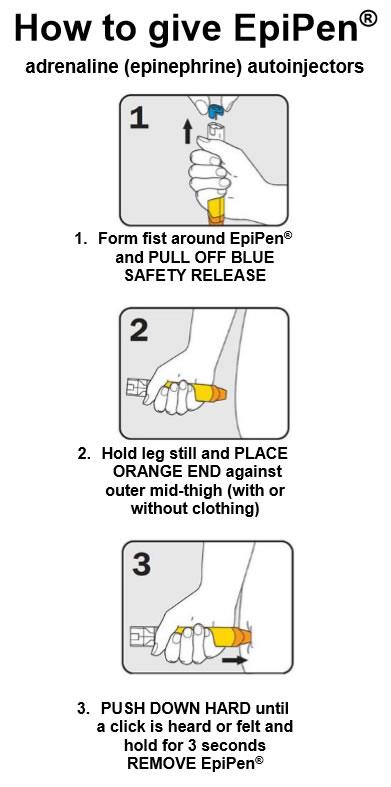Anaphylaxis (Severe Allergic Reaction)
FIRST AID FACT SHEET
What to do in the case of Anaphylaxis
A severe allergic reaction is the body’s immune system overreacting to a foreign substance. This is called Anaphylaxis and is potentially life-threatening.
What to do
- Follow DRSABCD St John Action Plan.
- Lay the casualty flat. If breathing is difficult allow them to sit. DO NOT allow them to stand or walk.
- If the casualty is carrying an adrenaline autoinjector, use it immediately. Ask the casualty if they need your help to use the adrenaline auto-injector.
- Urgent medical aid. Call Triple Zero (000) for an ambulance immediately.
- If required assist the casualty with an adrenaline autoinjector (EpiPen®).
++ Form a firm fist around the EpiPen® and pull off the BLUE SAFETY RELEASE.
++ Place ORANGE END against outer mid-thigh at a 90° angle (can be injected through clothing).
++ Push down hard until a click is heard or felt and hold in place for three (3) seconds.
++ Remove EpiPen® and dispose of it safely being careful of the needle.
++ Monitor the casualty, if no improvement, administer a second dose after 5 minutes. - Commence CPR and defibrillation at any time if the casualty is unconscious and is not breathing normally.
Caused by
- Food: Nuts, cow’s milk, eggs, fish, shellfish and soy products.
- Medications: Penicillin, Sulphur, antibiotics, Aspirin, Ibuprofen, Codeine or Morphine.
- Venom: Bites from ticks, stings from bees, wasps and ants.
Signs and symptoms
- Difficult and/or noisy breathing.
- Wheeze or persistent cough.
- Swelling of the face and tongue.
- Swelling/tightness of the throat.
- Difficulty talking and/or “hoarse” voice.
- Persistent dizziness or collapse.
- Young children may become pale and floppy.
- Abdominal pain and vomiting.
- Hives, welts and body redness.


